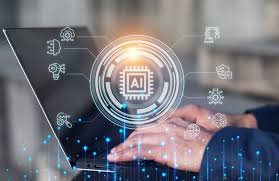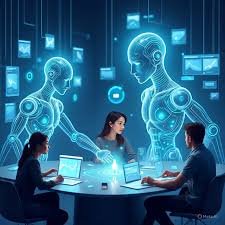Artificial Intelligence (AI) is no longer just a futuristic idea — it’s transforming how we live, work, and interact with technology. From personalized recommendations on Netflix to automated chatbots on websites, AI-powered software has become the backbone of modern digital innovation.
In the past, software followed strict, rule-based programming. But with the rise of AI, software can now learn, adapt, and make intelligent decisions on its own. This evolution is changing industries, boosting productivity, and opening doors to new possibilities.

🔹 What Is AI-Powered Software?
AI-powered software is any program or application that integrates artificial intelligence technologies — such as machine learning, deep learning, natural language processing (NLP), or computer vision — to perform tasks that normally require human intelligence.
Unlike traditional software, which depends entirely on predefined instructions, AI software improves over time by analyzing data, recognizing patterns, and learning from experience.
🔹 Key Technologies Behind AI-Powered Software
- Machine Learning (ML):
Enables software to learn from data and make predictions without explicit programming. Example: Spam email filters or credit scoring systems. - Natural Language Processing (NLP):
Helps machines understand and process human language. Example: ChatGPT, Siri, and Google Assistant. - Computer Vision:
Allows software to interpret and analyze visual inputs like images or videos. Example: Facial recognition, medical image analysis. - Deep Learning:
A more advanced form of ML using neural networks to handle complex data and make more accurate decisions. - Robotic Process Automation (RPA):
Automates repetitive tasks by mimicking human actions, often enhanced with AI to make smarter decisions.

🔹 Real-World Examples of AI-Powered Software
AI is now embedded in almost every industry and digital platform:
- 🏢 Business & Marketing:
CRMs like Salesforce Einstein and HubSpot AI predict customer behavior and automate marketing campaigns. - 🏥 Healthcare:
AI tools like IBM Watson Health analyze medical data to improve diagnostics and patient outcomes. - 💰 Finance:
AI software detects fraudulent transactions, predicts market trends, and automates trading. - 🛒 E-commerce:
Recommendation systems (like on Amazon) use AI to personalize the shopping experience. - 🎮 Gaming:
AI enhances game design, player experience, and adaptive difficulty systems. - 🚗 Automotive:
Self-driving cars use AI software to analyze surroundings, make real-time decisions, and ensure safety. - 🧠 Education:
AI-powered learning platforms customize lessons based on each student’s learning pace and performance.
🔹 Benefits of AI-Powered Software
AI-powered software delivers massive advantages across industries:
- Automation & Efficiency – Reduces manual workload and accelerates processes.
- Smart Decision-Making – Processes data faster and more accurately than humans.
- Cost Reduction – Minimizes human error and operational expenses.
- Personalization – Adapts to user preferences, improving engagement and satisfaction.
- Scalability – Easily manages large volumes of data and operations.
- Predictive Insights – Helps businesses plan ahead by analyzing trends and behaviors.
🔹 Challenges of AI-Powered Software
Despite its promise, AI integration comes with risks and challenges:
- Data Privacy Issues:
AI depends heavily on data; protecting user information is crucial. - Algorithmic Bias:
Poorly trained AI models can lead to unfair or inaccurate outcomes. - High Development Costs:
Building AI software requires skilled experts and powerful computing resources. - Lack of Transparency:
Deep learning models can act as “black boxes,” making it hard to explain their decisions. - Security Concerns:
Hackers can exploit AI systems or manipulate their data to cause harm.

🔹 Future of AI-Powered Software
The future of AI-powered software looks bright — and transformative.
By 2030, experts predict that over 80% of enterprise software will include AI components.
Emerging trends include:
- AI + Blockchain Integration for secure transactions
- Edge AI for faster data processing in real-time devices
- Generative AI for creative tasks (text, art, design, and music)
- Quantum AI for solving problems beyond classical computing
- Ethical AI Frameworks ensuring transparency and fairness
The goal of future AI software will be not only to automate but to augment human intelligence — making us more capable, creative, and efficient.
🔹 How Businesses Can Adopt AI-Powered Software
For companies planning to embrace AI-driven systems, here are essential steps:
- Assess Needs: Identify areas where AI can add the most value (marketing, operations, analytics).
- Invest in Quality Data: AI performance depends on accurate and diverse data.
- Start Small: Begin with pilot projects before scaling organization-wide.
- Collaborate with Experts: Partner with AI developers and data scientists.
- Ensure Compliance: Follow data protection and AI ethics guidelines.
- Train Your Team: Build awareness and technical skills for smooth adoption.

🔹 Conclusion
AI-powered software is shaping the next digital revolution. From automating tasks to predicting the future, it is redefining how technology interacts with people and data.
However, as AI continues to evolve, we must remain cautious — ensuring transparency, fairness, and ethical use. The true potential of AI lies not just in replacing human effort but in empowering human intelligence.
The future belongs to those who can harness the power of AI responsibly — creating software that is not only smart but also safe, ethical, and transformative.
